Cannabis Legalization with Strict Regulation: A Public Health Response
VerifiedAdded on 2023/06/14
|28
|9997
|364
Report
AI Summary
This report is a response to Kalant's commentary on cannabis policy, focusing on the potential of cannabis legalization with strict regulation to further public health goals. It argues that legalization, while not a perfect solution, offers the best opportunity to reduce overall harms associated with cannabis use. The report addresses concerns about increased use, emphasizing that the primary public health concern is reducing harm, not simply prevalence. It critiques the current criminal justice system's handling of cannabis offenses, highlighting issues of arbitrary enforcement and discrimination. The report concludes that the success of policy reform should be measured by a reduction in harms and costs associated with cannabis use, not just by changes in usage rates. Desklib offers a variety of resources, including past papers and solved assignments, to support students in their academic pursuits.
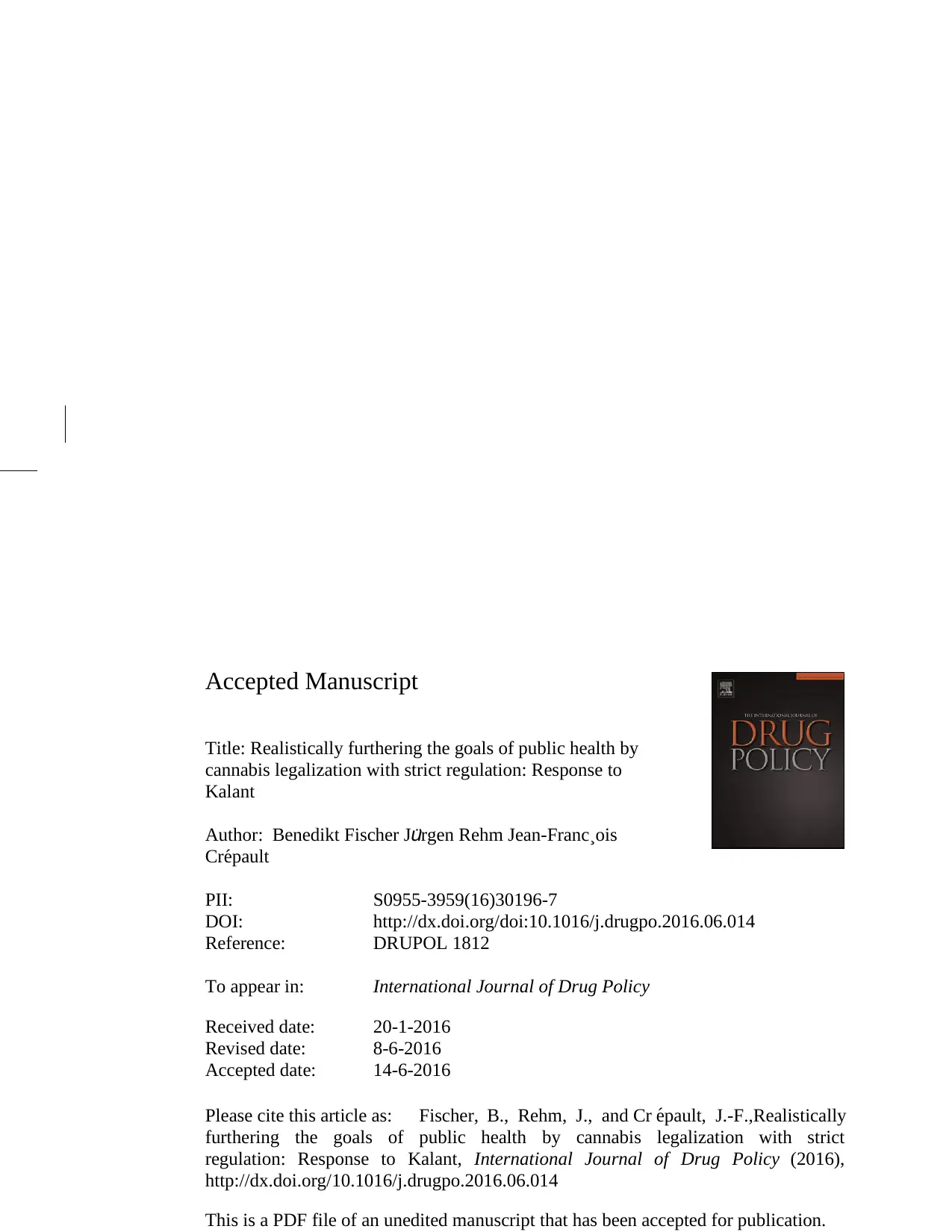
Accepted Manuscript
Title: Realistically furthering the goals of public health by
cannabis legalization with strict regulation: Response to
Kalant
Author: Benedikt Fischer J ¨urgen Rehm Jean-Franc¸ois
Cr´epault
PII: S0955-3959(16)30196-7
DOI: http://dx.doi.org/doi:10.1016/j.drugpo.2016.06.014
Reference: DRUPOL 1812
To appear in: International Journal of Drug Policy
Received date: 20-1-2016
Revised date: 8-6-2016
Accepted date: 14-6-2016
Please cite this article as: Fischer, B., Rehm, J., and Cr ´epault, J.-F.,Realistically
furthering the goals of public health by cannabis legalization with strict
regulation: Response to Kalant, International Journal of Drug Policy (2016),
http://dx.doi.org/10.1016/j.drugpo.2016.06.014
This is a PDF file of an unedited manuscript that has been accepted for publication.
Title: Realistically furthering the goals of public health by
cannabis legalization with strict regulation: Response to
Kalant
Author: Benedikt Fischer J ¨urgen Rehm Jean-Franc¸ois
Cr´epault
PII: S0955-3959(16)30196-7
DOI: http://dx.doi.org/doi:10.1016/j.drugpo.2016.06.014
Reference: DRUPOL 1812
To appear in: International Journal of Drug Policy
Received date: 20-1-2016
Revised date: 8-6-2016
Accepted date: 14-6-2016
Please cite this article as: Fischer, B., Rehm, J., and Cr ´epault, J.-F.,Realistically
furthering the goals of public health by cannabis legalization with strict
regulation: Response to Kalant, International Journal of Drug Policy (2016),
http://dx.doi.org/10.1016/j.drugpo.2016.06.014
This is a PDF file of an unedited manuscript that has been accepted for publication.
Paraphrase This Document
Need a fresh take? Get an instant paraphrase of this document with our AI Paraphraser
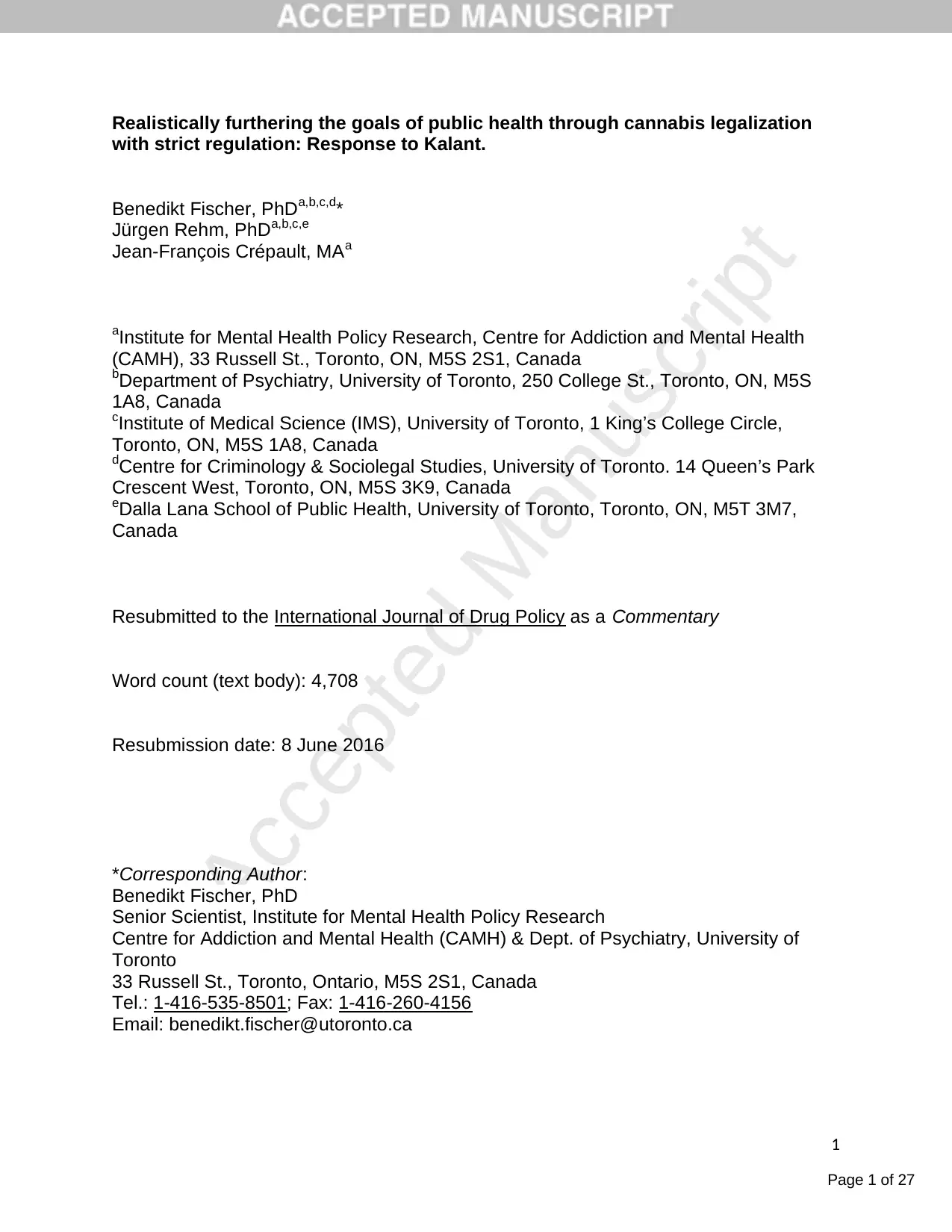
Page 1 of 27
Accepted Manuscript
1
Realistically furthering the goals of public health through cannabis legalization
with strict regulation: Response to Kalant.
Benedikt Fischer, PhDa,b,c,d*
Jürgen Rehm, PhDa,b,c,e
Jean-François Crépault, MAa
aInstitute for Mental Health Policy Research, Centre for Addiction and Mental Health
(CAMH), 33 Russell St., Toronto, ON, M5S 2S1, Canada
bDepartment of Psychiatry, University of Toronto, 250 College St., Toronto, ON, M5S
1A8, Canada
cInstitute of Medical Science (IMS), University of Toronto, 1 King’s College Circle,
Toronto, ON, M5S 1A8, Canada
dCentre for Criminology & Sociolegal Studies, University of Toronto. 14 Queen’s Park
Crescent West, Toronto, ON, M5S 3K9, Canada
eDalla Lana School of Public Health, University of Toronto, Toronto, ON, M5T 3M7,
Canada
Resubmitted to the International Journal of Drug Policy as a Commentary
Word count (text body): 4,708
Resubmission date: 8 June 2016
*Corresponding Author:
Benedikt Fischer, PhD
Senior Scientist, Institute for Mental Health Policy Research
Centre for Addiction and Mental Health (CAMH) & Dept. of Psychiatry, University of
Toronto
33 Russell St., Toronto, Ontario, M5S 2S1, Canada
Tel.: 1-416-535-8501; Fax: 1-416-260-4156
Email: benedikt.fischer@utoronto.ca
Accepted Manuscript
1
Realistically furthering the goals of public health through cannabis legalization
with strict regulation: Response to Kalant.
Benedikt Fischer, PhDa,b,c,d*
Jürgen Rehm, PhDa,b,c,e
Jean-François Crépault, MAa
aInstitute for Mental Health Policy Research, Centre for Addiction and Mental Health
(CAMH), 33 Russell St., Toronto, ON, M5S 2S1, Canada
bDepartment of Psychiatry, University of Toronto, 250 College St., Toronto, ON, M5S
1A8, Canada
cInstitute of Medical Science (IMS), University of Toronto, 1 King’s College Circle,
Toronto, ON, M5S 1A8, Canada
dCentre for Criminology & Sociolegal Studies, University of Toronto. 14 Queen’s Park
Crescent West, Toronto, ON, M5S 3K9, Canada
eDalla Lana School of Public Health, University of Toronto, Toronto, ON, M5T 3M7,
Canada
Resubmitted to the International Journal of Drug Policy as a Commentary
Word count (text body): 4,708
Resubmission date: 8 June 2016
*Corresponding Author:
Benedikt Fischer, PhD
Senior Scientist, Institute for Mental Health Policy Research
Centre for Addiction and Mental Health (CAMH) & Dept. of Psychiatry, University of
Toronto
33 Russell St., Toronto, Ontario, M5S 2S1, Canada
Tel.: 1-416-535-8501; Fax: 1-416-260-4156
Email: benedikt.fischer@utoronto.ca
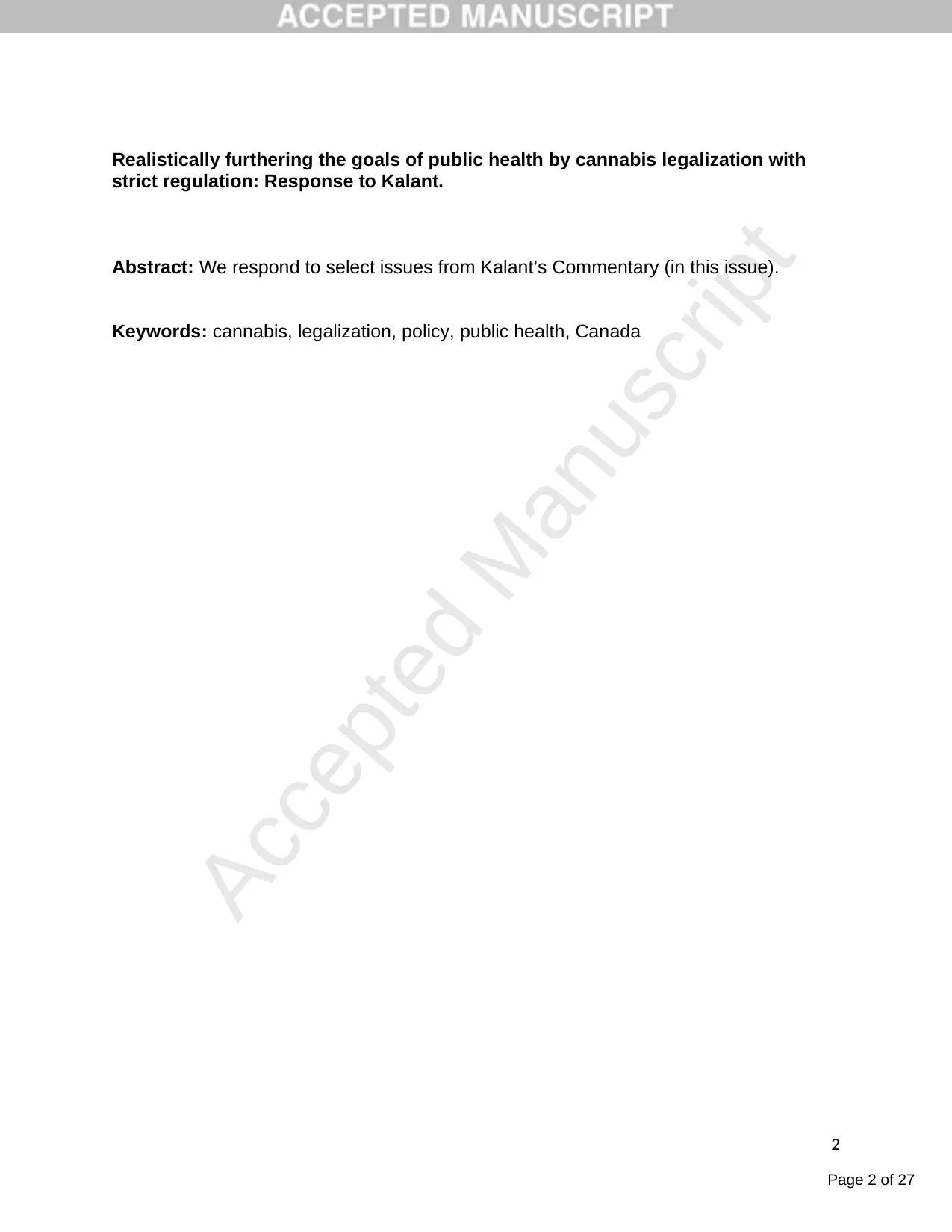
Page 2 of 27
Accepted Manuscript
2
Realistically furthering the goals of public health by cannabis legalization with
strict regulation: Response to Kalant.
Abstract: We respond to select issues from Kalant’s Commentary (in this issue).
Keywords: cannabis, legalization, policy, public health, Canada
Accepted Manuscript
2
Realistically furthering the goals of public health by cannabis legalization with
strict regulation: Response to Kalant.
Abstract: We respond to select issues from Kalant’s Commentary (in this issue).
Keywords: cannabis, legalization, policy, public health, Canada
⊘ This is a preview!⊘
Do you want full access?
Subscribe today to unlock all pages.

Trusted by 1+ million students worldwide
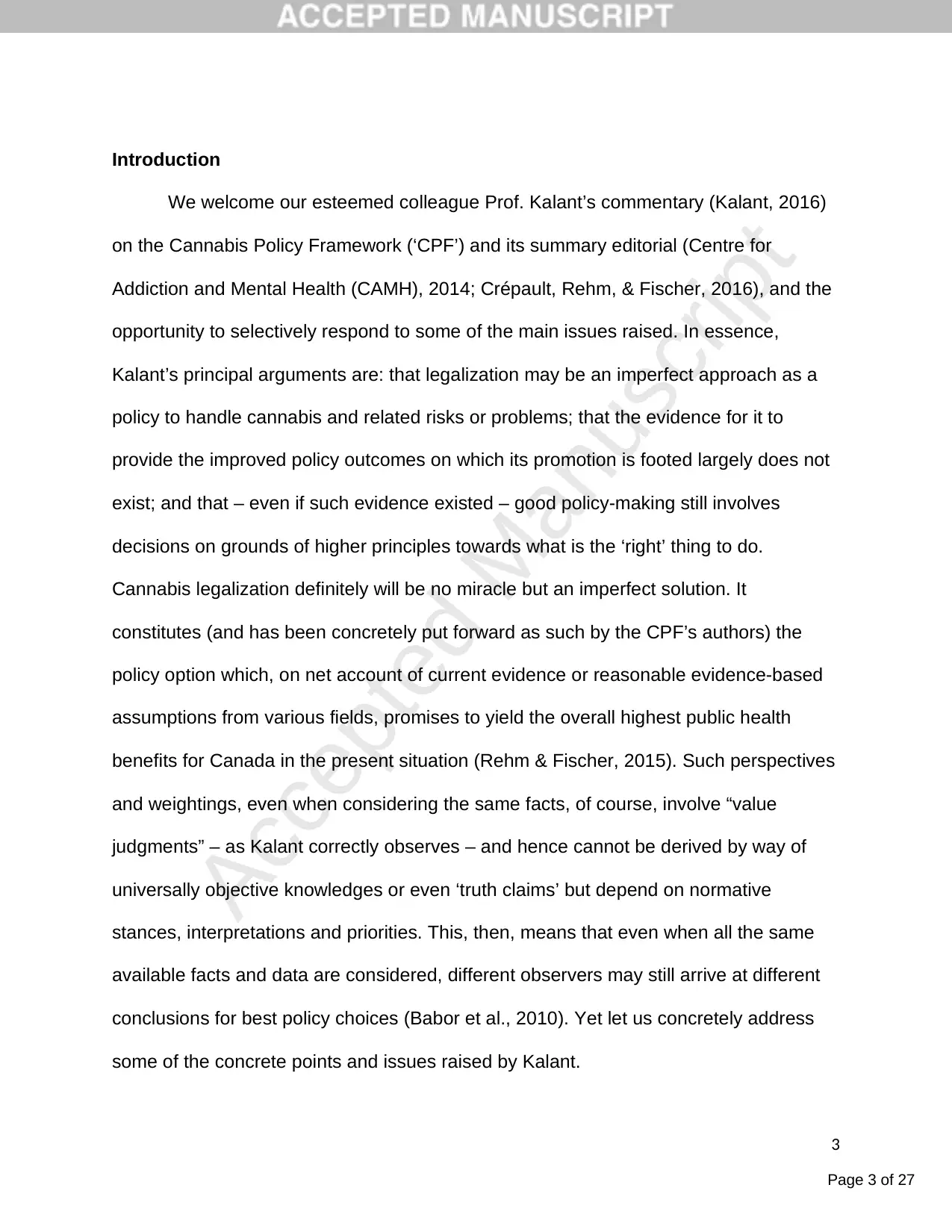
Page 3 of 27
Accepted Manuscript
3
Introduction
We welcome our esteemed colleague Prof. Kalant’s commentary (Kalant, 2016)
on the Cannabis Policy Framework (‘CPF’) and its summary editorial (Centre for
Addiction and Mental Health (CAMH), 2014; Crépault, Rehm, & Fischer, 2016), and the
opportunity to selectively respond to some of the main issues raised. In essence,
Kalant’s principal arguments are: that legalization may be an imperfect approach as a
policy to handle cannabis and related risks or problems; that the evidence for it to
provide the improved policy outcomes on which its promotion is footed largely does not
exist; and that – even if such evidence existed – good policy-making still involves
decisions on grounds of higher principles towards what is the ‘right’ thing to do.
Cannabis legalization definitely will be no miracle but an imperfect solution. It
constitutes (and has been concretely put forward as such by the CPF’s authors) the
policy option which, on net account of current evidence or reasonable evidence-based
assumptions from various fields, promises to yield the overall highest public health
benefits for Canada in the present situation (Rehm & Fischer, 2015). Such perspectives
and weightings, even when considering the same facts, of course, involve “value
judgments” – as Kalant correctly observes – and hence cannot be derived by way of
universally objective knowledges or even ‘truth claims’ but depend on normative
stances, interpretations and priorities. This, then, means that even when all the same
available facts and data are considered, different observers may still arrive at different
conclusions for best policy choices (Babor et al., 2010). Yet let us concretely address
some of the concrete points and issues raised by Kalant.
Accepted Manuscript
3
Introduction
We welcome our esteemed colleague Prof. Kalant’s commentary (Kalant, 2016)
on the Cannabis Policy Framework (‘CPF’) and its summary editorial (Centre for
Addiction and Mental Health (CAMH), 2014; Crépault, Rehm, & Fischer, 2016), and the
opportunity to selectively respond to some of the main issues raised. In essence,
Kalant’s principal arguments are: that legalization may be an imperfect approach as a
policy to handle cannabis and related risks or problems; that the evidence for it to
provide the improved policy outcomes on which its promotion is footed largely does not
exist; and that – even if such evidence existed – good policy-making still involves
decisions on grounds of higher principles towards what is the ‘right’ thing to do.
Cannabis legalization definitely will be no miracle but an imperfect solution. It
constitutes (and has been concretely put forward as such by the CPF’s authors) the
policy option which, on net account of current evidence or reasonable evidence-based
assumptions from various fields, promises to yield the overall highest public health
benefits for Canada in the present situation (Rehm & Fischer, 2015). Such perspectives
and weightings, even when considering the same facts, of course, involve “value
judgments” – as Kalant correctly observes – and hence cannot be derived by way of
universally objective knowledges or even ‘truth claims’ but depend on normative
stances, interpretations and priorities. This, then, means that even when all the same
available facts and data are considered, different observers may still arrive at different
conclusions for best policy choices (Babor et al., 2010). Yet let us concretely address
some of the concrete points and issues raised by Kalant.
Paraphrase This Document
Need a fresh take? Get an instant paraphrase of this document with our AI Paraphraser
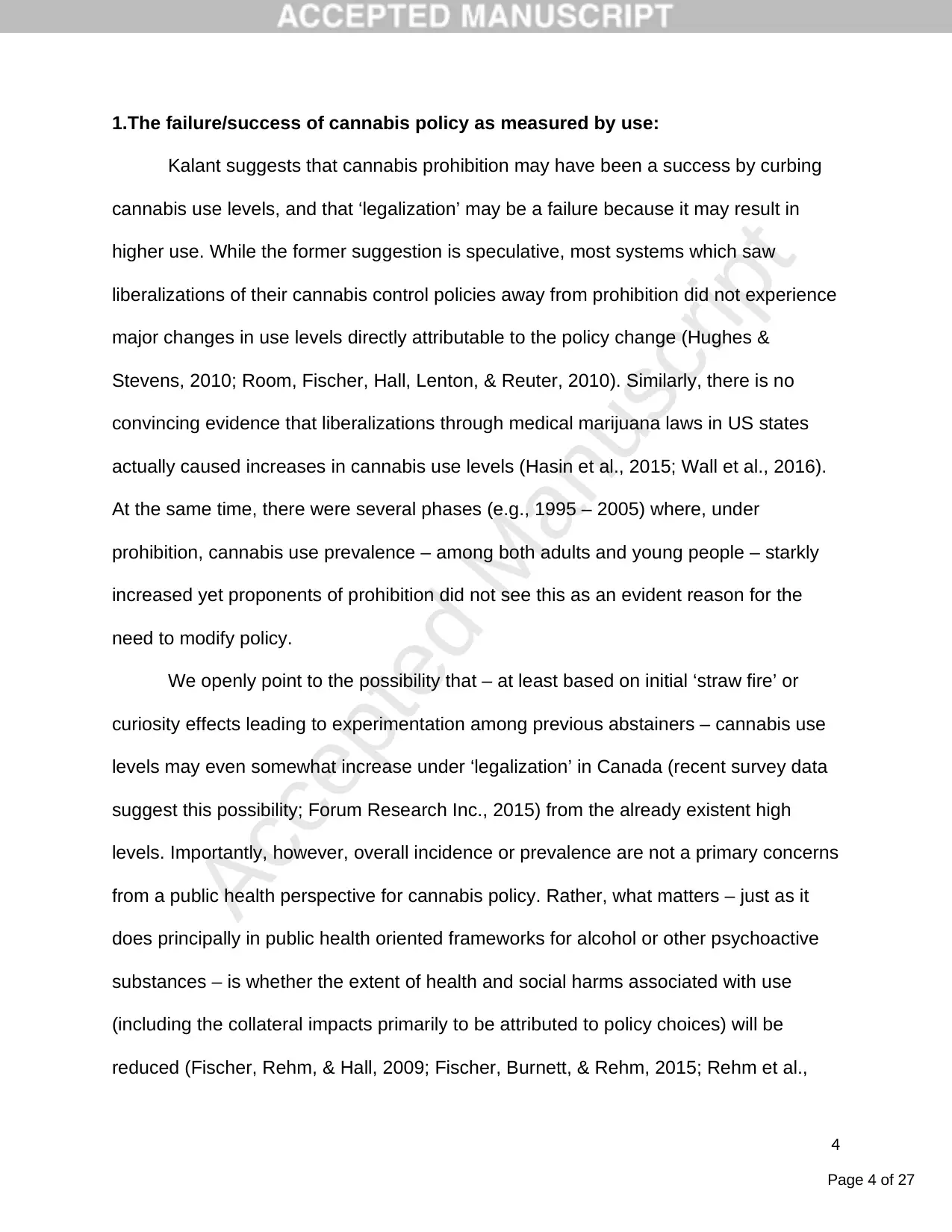
Page 4 of 27
Accepted Manuscript
4
1.The failure/success of cannabis policy as measured by use:
Kalant suggests that cannabis prohibition may have been a success by curbing
cannabis use levels, and that ‘legalization’ may be a failure because it may result in
higher use. While the former suggestion is speculative, most systems which saw
liberalizations of their cannabis control policies away from prohibition did not experience
major changes in use levels directly attributable to the policy change (Hughes &
Stevens, 2010; Room, Fischer, Hall, Lenton, & Reuter, 2010). Similarly, there is no
convincing evidence that liberalizations through medical marijuana laws in US states
actually caused increases in cannabis use levels (Hasin et al., 2015; Wall et al., 2016).
At the same time, there were several phases (e.g., 1995 – 2005) where, under
prohibition, cannabis use prevalence – among both adults and young people – starkly
increased yet proponents of prohibition did not see this as an evident reason for the
need to modify policy.
We openly point to the possibility that – at least based on initial ‘straw fire’ or
curiosity effects leading to experimentation among previous abstainers – cannabis use
levels may even somewhat increase under ‘legalization’ in Canada (recent survey data
suggest this possibility; Forum Research Inc., 2015) from the already existent high
levels. Importantly, however, overall incidence or prevalence are not a primary concerns
from a public health perspective for cannabis policy. Rather, what matters – just as it
does principally in public health oriented frameworks for alcohol or other psychoactive
substances – is whether the extent of health and social harms associated with use
(including the collateral impacts primarily to be attributed to policy choices) will be
reduced (Fischer, Rehm, & Hall, 2009; Fischer, Burnett, & Rehm, 2015; Rehm et al.,
Accepted Manuscript
4
1.The failure/success of cannabis policy as measured by use:
Kalant suggests that cannabis prohibition may have been a success by curbing
cannabis use levels, and that ‘legalization’ may be a failure because it may result in
higher use. While the former suggestion is speculative, most systems which saw
liberalizations of their cannabis control policies away from prohibition did not experience
major changes in use levels directly attributable to the policy change (Hughes &
Stevens, 2010; Room, Fischer, Hall, Lenton, & Reuter, 2010). Similarly, there is no
convincing evidence that liberalizations through medical marijuana laws in US states
actually caused increases in cannabis use levels (Hasin et al., 2015; Wall et al., 2016).
At the same time, there were several phases (e.g., 1995 – 2005) where, under
prohibition, cannabis use prevalence – among both adults and young people – starkly
increased yet proponents of prohibition did not see this as an evident reason for the
need to modify policy.
We openly point to the possibility that – at least based on initial ‘straw fire’ or
curiosity effects leading to experimentation among previous abstainers – cannabis use
levels may even somewhat increase under ‘legalization’ in Canada (recent survey data
suggest this possibility; Forum Research Inc., 2015) from the already existent high
levels. Importantly, however, overall incidence or prevalence are not a primary concerns
from a public health perspective for cannabis policy. Rather, what matters – just as it
does principally in public health oriented frameworks for alcohol or other psychoactive
substances – is whether the extent of health and social harms associated with use
(including the collateral impacts primarily to be attributed to policy choices) will be
reduced (Fischer, Rehm, & Hall, 2009; Fischer, Burnett, & Rehm, 2015; Rehm et al.,
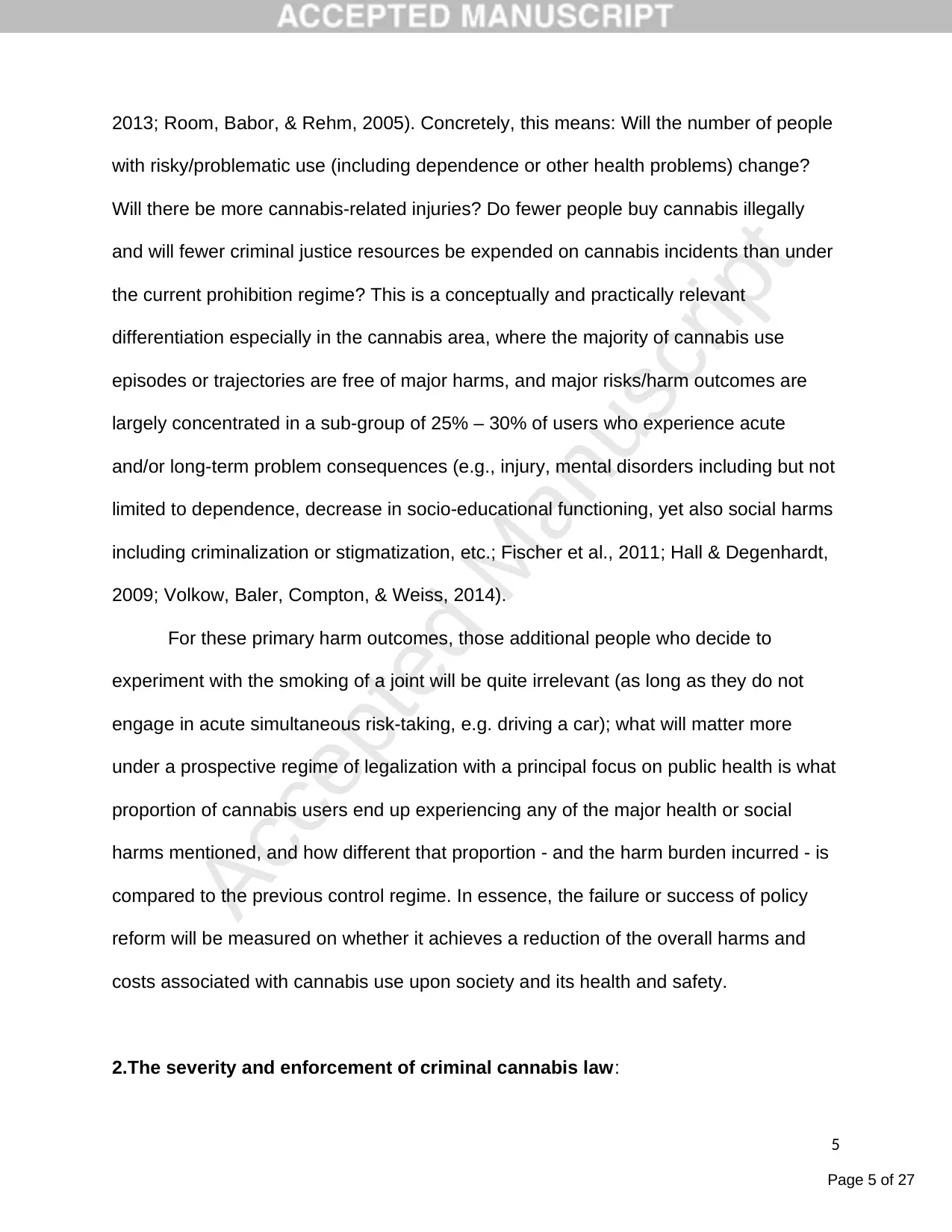
Page 5 of 27
Accepted Manuscript
5
2013; Room, Babor, & Rehm, 2005). Concretely, this means: Will the number of people
with risky/problematic use (including dependence or other health problems) change?
Will there be more cannabis-related injuries? Do fewer people buy cannabis illegally
and will fewer criminal justice resources be expended on cannabis incidents than under
the current prohibition regime? This is a conceptually and practically relevant
differentiation especially in the cannabis area, where the majority of cannabis use
episodes or trajectories are free of major harms, and major risks/harm outcomes are
largely concentrated in a sub-group of 25% – 30% of users who experience acute
and/or long-term problem consequences (e.g., injury, mental disorders including but not
limited to dependence, decrease in socio-educational functioning, yet also social harms
including criminalization or stigmatization, etc.; Fischer et al., 2011; Hall & Degenhardt,
2009; Volkow, Baler, Compton, & Weiss, 2014).
For these primary harm outcomes, those additional people who decide to
experiment with the smoking of a joint will be quite irrelevant (as long as they do not
engage in acute simultaneous risk-taking, e.g. driving a car); what will matter more
under a prospective regime of legalization with a principal focus on public health is what
proportion of cannabis users end up experiencing any of the major health or social
harms mentioned, and how different that proportion - and the harm burden incurred - is
compared to the previous control regime. In essence, the failure or success of policy
reform will be measured on whether it achieves a reduction of the overall harms and
costs associated with cannabis use upon society and its health and safety.
2.The severity and enforcement of criminal cannabis law:
Accepted Manuscript
5
2013; Room, Babor, & Rehm, 2005). Concretely, this means: Will the number of people
with risky/problematic use (including dependence or other health problems) change?
Will there be more cannabis-related injuries? Do fewer people buy cannabis illegally
and will fewer criminal justice resources be expended on cannabis incidents than under
the current prohibition regime? This is a conceptually and practically relevant
differentiation especially in the cannabis area, where the majority of cannabis use
episodes or trajectories are free of major harms, and major risks/harm outcomes are
largely concentrated in a sub-group of 25% – 30% of users who experience acute
and/or long-term problem consequences (e.g., injury, mental disorders including but not
limited to dependence, decrease in socio-educational functioning, yet also social harms
including criminalization or stigmatization, etc.; Fischer et al., 2011; Hall & Degenhardt,
2009; Volkow, Baler, Compton, & Weiss, 2014).
For these primary harm outcomes, those additional people who decide to
experiment with the smoking of a joint will be quite irrelevant (as long as they do not
engage in acute simultaneous risk-taking, e.g. driving a car); what will matter more
under a prospective regime of legalization with a principal focus on public health is what
proportion of cannabis users end up experiencing any of the major health or social
harms mentioned, and how different that proportion - and the harm burden incurred - is
compared to the previous control regime. In essence, the failure or success of policy
reform will be measured on whether it achieves a reduction of the overall harms and
costs associated with cannabis use upon society and its health and safety.
2.The severity and enforcement of criminal cannabis law:
⊘ This is a preview!⊘
Do you want full access?
Subscribe today to unlock all pages.

Trusted by 1+ million students worldwide
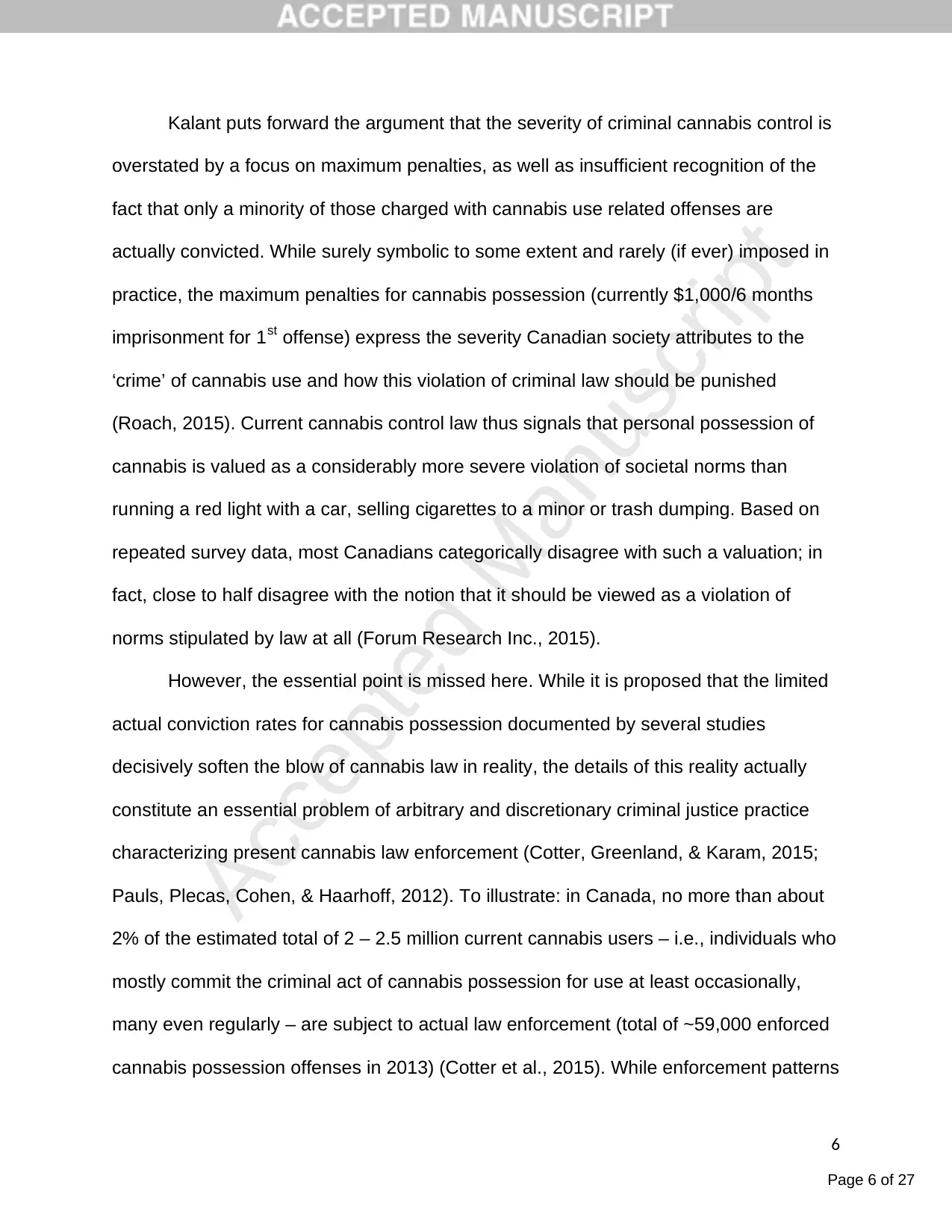
Page 6 of 27
Accepted Manuscript
6
Kalant puts forward the argument that the severity of criminal cannabis control is
overstated by a focus on maximum penalties, as well as insufficient recognition of the
fact that only a minority of those charged with cannabis use related offenses are
actually convicted. While surely symbolic to some extent and rarely (if ever) imposed in
practice, the maximum penalties for cannabis possession (currently $1,000/6 months
imprisonment for 1st offense) express the severity Canadian society attributes to the
‘crime’ of cannabis use and how this violation of criminal law should be punished
(Roach, 2015). Current cannabis control law thus signals that personal possession of
cannabis is valued as a considerably more severe violation of societal norms than
running a red light with a car, selling cigarettes to a minor or trash dumping. Based on
repeated survey data, most Canadians categorically disagree with such a valuation; in
fact, close to half disagree with the notion that it should be viewed as a violation of
norms stipulated by law at all (Forum Research Inc., 2015).
However, the essential point is missed here. While it is proposed that the limited
actual conviction rates for cannabis possession documented by several studies
decisively soften the blow of cannabis law in reality, the details of this reality actually
constitute an essential problem of arbitrary and discretionary criminal justice practice
characterizing present cannabis law enforcement (Cotter, Greenland, & Karam, 2015;
Pauls, Plecas, Cohen, & Haarhoff, 2012). To illustrate: in Canada, no more than about
2% of the estimated total of 2 – 2.5 million current cannabis users – i.e., individuals who
mostly commit the criminal act of cannabis possession for use at least occasionally,
many even regularly – are subject to actual law enforcement (total of ~59,000 enforced
cannabis possession offenses in 2013) (Cotter et al., 2015). While enforcement patterns
Accepted Manuscript
6
Kalant puts forward the argument that the severity of criminal cannabis control is
overstated by a focus on maximum penalties, as well as insufficient recognition of the
fact that only a minority of those charged with cannabis use related offenses are
actually convicted. While surely symbolic to some extent and rarely (if ever) imposed in
practice, the maximum penalties for cannabis possession (currently $1,000/6 months
imprisonment for 1st offense) express the severity Canadian society attributes to the
‘crime’ of cannabis use and how this violation of criminal law should be punished
(Roach, 2015). Current cannabis control law thus signals that personal possession of
cannabis is valued as a considerably more severe violation of societal norms than
running a red light with a car, selling cigarettes to a minor or trash dumping. Based on
repeated survey data, most Canadians categorically disagree with such a valuation; in
fact, close to half disagree with the notion that it should be viewed as a violation of
norms stipulated by law at all (Forum Research Inc., 2015).
However, the essential point is missed here. While it is proposed that the limited
actual conviction rates for cannabis possession documented by several studies
decisively soften the blow of cannabis law in reality, the details of this reality actually
constitute an essential problem of arbitrary and discretionary criminal justice practice
characterizing present cannabis law enforcement (Cotter, Greenland, & Karam, 2015;
Pauls, Plecas, Cohen, & Haarhoff, 2012). To illustrate: in Canada, no more than about
2% of the estimated total of 2 – 2.5 million current cannabis users – i.e., individuals who
mostly commit the criminal act of cannabis possession for use at least occasionally,
many even regularly – are subject to actual law enforcement (total of ~59,000 enforced
cannabis possession offenses in 2013) (Cotter et al., 2015). While enforcement patterns
Paraphrase This Document
Need a fresh take? Get an instant paraphrase of this document with our AI Paraphraser
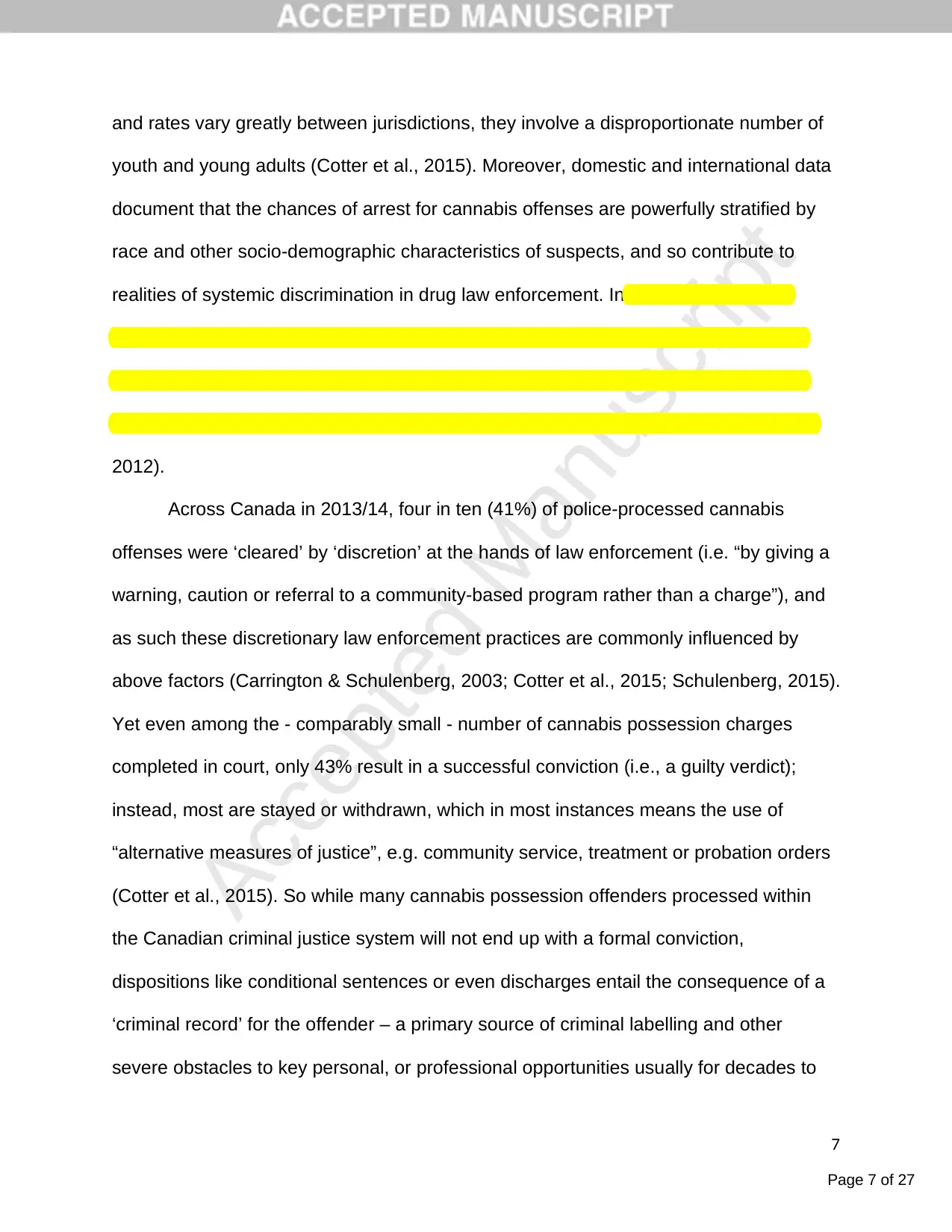
Page 7 of 27
Accepted Manuscript
7
and rates vary greatly between jurisdictions, they involve a disproportionate number of
youth and young adults (Cotter et al., 2015). Moreover, domestic and international data
document that the chances of arrest for cannabis offenses are powerfully stratified by
race and other socio-demographic characteristics of suspects, and so contribute to
realities of systemic discrimination in drug law enforcement. In addition, arrests for
suspected cannabis violations are commonly used as a discretionary yet convenient
tool by law enforcement personnel for access to ‘suspicious populations’ for criminal
investigation purposes (Golub, Johnson, & Dunlap, 2007; Wortley & Owusu-Bempah,
2012).
Across Canada in 2013/14, four in ten (41%) of police-processed cannabis
offenses were ‘cleared’ by ‘discretion’ at the hands of law enforcement (i.e. “by giving a
warning, caution or referral to a community-based program rather than a charge”), and
as such these discretionary law enforcement practices are commonly influenced by
above factors (Carrington & Schulenberg, 2003; Cotter et al., 2015; Schulenberg, 2015).
Yet even among the - comparably small - number of cannabis possession charges
completed in court, only 43% result in a successful conviction (i.e., a guilty verdict);
instead, most are stayed or withdrawn, which in most instances means the use of
“alternative measures of justice”, e.g. community service, treatment or probation orders
(Cotter et al., 2015). So while many cannabis possession offenders processed within
the Canadian criminal justice system will not end up with a formal conviction,
dispositions like conditional sentences or even discharges entail the consequence of a
‘criminal record’ for the offender – a primary source of criminal labelling and other
severe obstacles to key personal, or professional opportunities usually for decades to
Accepted Manuscript
7
and rates vary greatly between jurisdictions, they involve a disproportionate number of
youth and young adults (Cotter et al., 2015). Moreover, domestic and international data
document that the chances of arrest for cannabis offenses are powerfully stratified by
race and other socio-demographic characteristics of suspects, and so contribute to
realities of systemic discrimination in drug law enforcement. In addition, arrests for
suspected cannabis violations are commonly used as a discretionary yet convenient
tool by law enforcement personnel for access to ‘suspicious populations’ for criminal
investigation purposes (Golub, Johnson, & Dunlap, 2007; Wortley & Owusu-Bempah,
2012).
Across Canada in 2013/14, four in ten (41%) of police-processed cannabis
offenses were ‘cleared’ by ‘discretion’ at the hands of law enforcement (i.e. “by giving a
warning, caution or referral to a community-based program rather than a charge”), and
as such these discretionary law enforcement practices are commonly influenced by
above factors (Carrington & Schulenberg, 2003; Cotter et al., 2015; Schulenberg, 2015).
Yet even among the - comparably small - number of cannabis possession charges
completed in court, only 43% result in a successful conviction (i.e., a guilty verdict);
instead, most are stayed or withdrawn, which in most instances means the use of
“alternative measures of justice”, e.g. community service, treatment or probation orders
(Cotter et al., 2015). So while many cannabis possession offenders processed within
the Canadian criminal justice system will not end up with a formal conviction,
dispositions like conditional sentences or even discharges entail the consequence of a
‘criminal record’ for the offender – a primary source of criminal labelling and other
severe obstacles to key personal, or professional opportunities usually for decades to
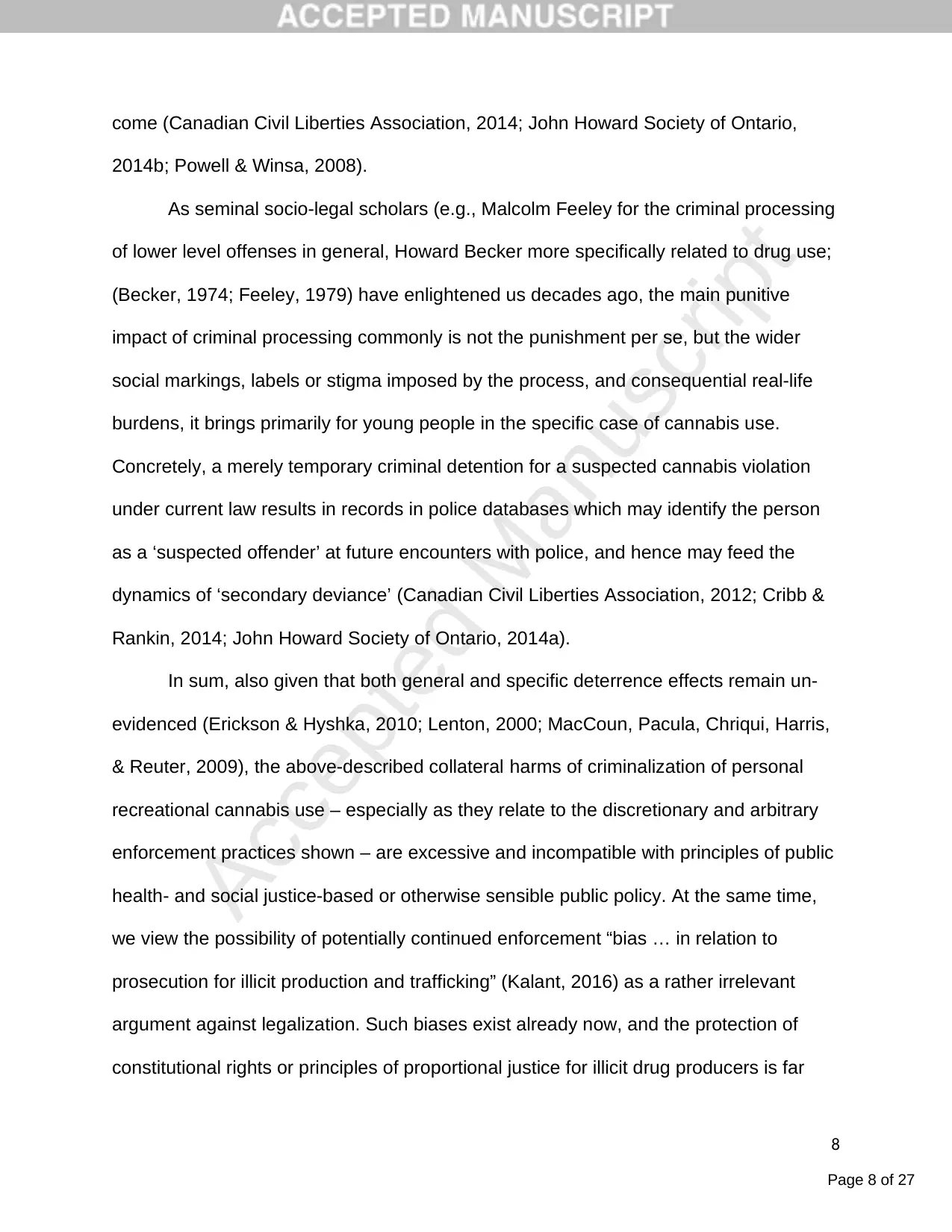
Page 8 of 27
Accepted Manuscript
8
come (Canadian Civil Liberties Association, 2014; John Howard Society of Ontario,
2014b; Powell & Winsa, 2008).
As seminal socio-legal scholars (e.g., Malcolm Feeley for the criminal processing
of lower level offenses in general, Howard Becker more specifically related to drug use;
(Becker, 1974; Feeley, 1979) have enlightened us decades ago, the main punitive
impact of criminal processing commonly is not the punishment per se, but the wider
social markings, labels or stigma imposed by the process, and consequential real-life
burdens, it brings primarily for young people in the specific case of cannabis use.
Concretely, a merely temporary criminal detention for a suspected cannabis violation
under current law results in records in police databases which may identify the person
as a ‘suspected offender’ at future encounters with police, and hence may feed the
dynamics of ‘secondary deviance’ (Canadian Civil Liberties Association, 2012; Cribb &
Rankin, 2014; John Howard Society of Ontario, 2014a).
In sum, also given that both general and specific deterrence effects remain un-
evidenced (Erickson & Hyshka, 2010; Lenton, 2000; MacCoun, Pacula, Chriqui, Harris,
& Reuter, 2009), the above-described collateral harms of criminalization of personal
recreational cannabis use – especially as they relate to the discretionary and arbitrary
enforcement practices shown – are excessive and incompatible with principles of public
health- and social justice-based or otherwise sensible public policy. At the same time,
we view the possibility of potentially continued enforcement “bias … in relation to
prosecution for illicit production and trafficking” (Kalant, 2016) as a rather irrelevant
argument against legalization. Such biases exist already now, and the protection of
constitutional rights or principles of proportional justice for illicit drug producers is far
Accepted Manuscript
8
come (Canadian Civil Liberties Association, 2014; John Howard Society of Ontario,
2014b; Powell & Winsa, 2008).
As seminal socio-legal scholars (e.g., Malcolm Feeley for the criminal processing
of lower level offenses in general, Howard Becker more specifically related to drug use;
(Becker, 1974; Feeley, 1979) have enlightened us decades ago, the main punitive
impact of criminal processing commonly is not the punishment per se, but the wider
social markings, labels or stigma imposed by the process, and consequential real-life
burdens, it brings primarily for young people in the specific case of cannabis use.
Concretely, a merely temporary criminal detention for a suspected cannabis violation
under current law results in records in police databases which may identify the person
as a ‘suspected offender’ at future encounters with police, and hence may feed the
dynamics of ‘secondary deviance’ (Canadian Civil Liberties Association, 2012; Cribb &
Rankin, 2014; John Howard Society of Ontario, 2014a).
In sum, also given that both general and specific deterrence effects remain un-
evidenced (Erickson & Hyshka, 2010; Lenton, 2000; MacCoun, Pacula, Chriqui, Harris,
& Reuter, 2009), the above-described collateral harms of criminalization of personal
recreational cannabis use – especially as they relate to the discretionary and arbitrary
enforcement practices shown – are excessive and incompatible with principles of public
health- and social justice-based or otherwise sensible public policy. At the same time,
we view the possibility of potentially continued enforcement “bias … in relation to
prosecution for illicit production and trafficking” (Kalant, 2016) as a rather irrelevant
argument against legalization. Such biases exist already now, and the protection of
constitutional rights or principles of proportional justice for illicit drug producers is far
⊘ This is a preview!⊘
Do you want full access?
Subscribe today to unlock all pages.

Trusted by 1+ million students worldwide
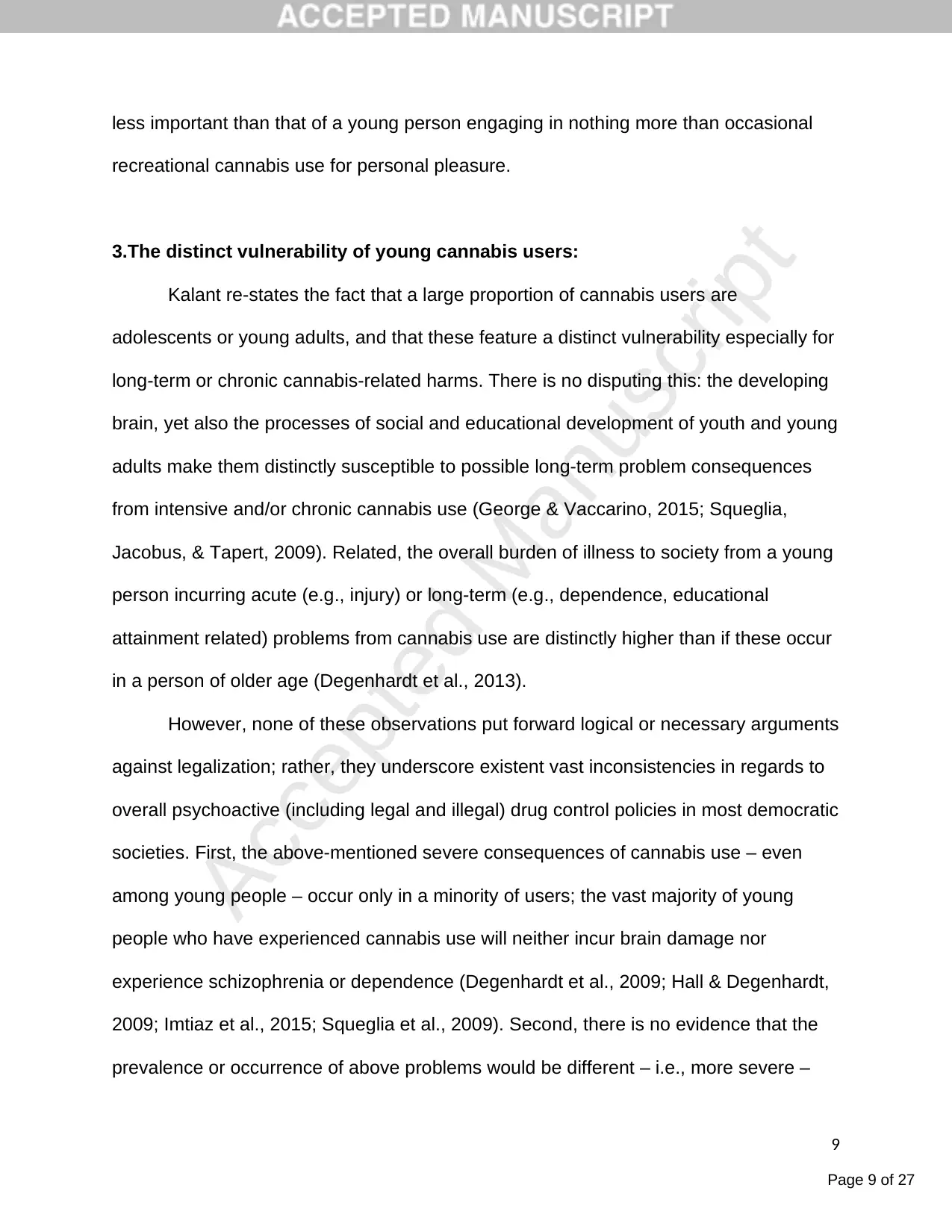
Page 9 of 27
Accepted Manuscript
9
less important than that of a young person engaging in nothing more than occasional
recreational cannabis use for personal pleasure.
3.The distinct vulnerability of young cannabis users:
Kalant re-states the fact that a large proportion of cannabis users are
adolescents or young adults, and that these feature a distinct vulnerability especially for
long-term or chronic cannabis-related harms. There is no disputing this: the developing
brain, yet also the processes of social and educational development of youth and young
adults make them distinctly susceptible to possible long-term problem consequences
from intensive and/or chronic cannabis use (George & Vaccarino, 2015; Squeglia,
Jacobus, & Tapert, 2009). Related, the overall burden of illness to society from a young
person incurring acute (e.g., injury) or long-term (e.g., dependence, educational
attainment related) problems from cannabis use are distinctly higher than if these occur
in a person of older age (Degenhardt et al., 2013).
However, none of these observations put forward logical or necessary arguments
against legalization; rather, they underscore existent vast inconsistencies in regards to
overall psychoactive (including legal and illegal) drug control policies in most democratic
societies. First, the above-mentioned severe consequences of cannabis use – even
among young people – occur only in a minority of users; the vast majority of young
people who have experienced cannabis use will neither incur brain damage nor
experience schizophrenia or dependence (Degenhardt et al., 2009; Hall & Degenhardt,
2009; Imtiaz et al., 2015; Squeglia et al., 2009). Second, there is no evidence that the
prevalence or occurrence of above problems would be different – i.e., more severe –
Accepted Manuscript
9
less important than that of a young person engaging in nothing more than occasional
recreational cannabis use for personal pleasure.
3.The distinct vulnerability of young cannabis users:
Kalant re-states the fact that a large proportion of cannabis users are
adolescents or young adults, and that these feature a distinct vulnerability especially for
long-term or chronic cannabis-related harms. There is no disputing this: the developing
brain, yet also the processes of social and educational development of youth and young
adults make them distinctly susceptible to possible long-term problem consequences
from intensive and/or chronic cannabis use (George & Vaccarino, 2015; Squeglia,
Jacobus, & Tapert, 2009). Related, the overall burden of illness to society from a young
person incurring acute (e.g., injury) or long-term (e.g., dependence, educational
attainment related) problems from cannabis use are distinctly higher than if these occur
in a person of older age (Degenhardt et al., 2013).
However, none of these observations put forward logical or necessary arguments
against legalization; rather, they underscore existent vast inconsistencies in regards to
overall psychoactive (including legal and illegal) drug control policies in most democratic
societies. First, the above-mentioned severe consequences of cannabis use – even
among young people – occur only in a minority of users; the vast majority of young
people who have experienced cannabis use will neither incur brain damage nor
experience schizophrenia or dependence (Degenhardt et al., 2009; Hall & Degenhardt,
2009; Imtiaz et al., 2015; Squeglia et al., 2009). Second, there is no evidence that the
prevalence or occurrence of above problems would be different – i.e., more severe –
Paraphrase This Document
Need a fresh take? Get an instant paraphrase of this document with our AI Paraphraser
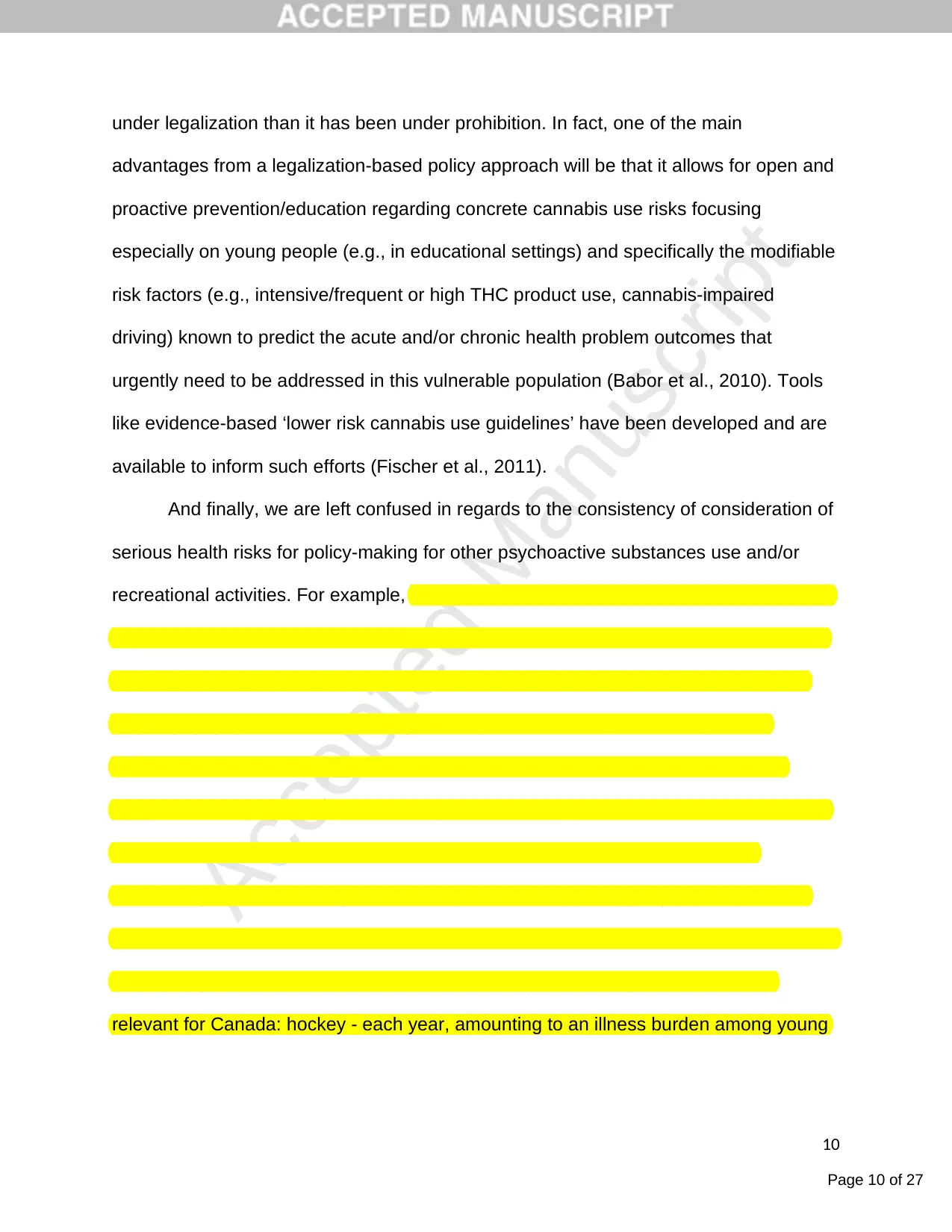
Page 10 of 27
Accepted Manuscript
10
under legalization than it has been under prohibition. In fact, one of the main
advantages from a legalization-based policy approach will be that it allows for open and
proactive prevention/education regarding concrete cannabis use risks focusing
especially on young people (e.g., in educational settings) and specifically the modifiable
risk factors (e.g., intensive/frequent or high THC product use, cannabis-impaired
driving) known to predict the acute and/or chronic health problem outcomes that
urgently need to be addressed in this vulnerable population (Babor et al., 2010). Tools
like evidence-based ‘lower risk cannabis use guidelines’ have been developed and are
available to inform such efforts (Fischer et al., 2011).
And finally, we are left confused in regards to the consistency of consideration of
serious health risks for policy-making for other psychoactive substances use and/or
recreational activities. For example, many more young (including underage) people use
alcohol than cannabis in Canada, and the risks for brain health harms from alcohol are
at least as high if not higher (Bava & Tapert, 2010; Squeglia et al., 2009); other risks
(e.g., injury, physical/mental health problems) are at least equal but likely worse
(Lachenmeier & Rehm, 2015; Nutt, King, & Phillips, 2010; Rehm, Lachenmeier, &
Room, 2014; Squeglia et al., 2009; Zeigler et al., 2005). There is extensive evidence of
negative associations of alcohol and tobacco use – and little evidence on their
‘reversibility’ - on various aspects of intelligence among young people (Odgers et al.,
2008; Trinidad & Johnson, 2002). Notably, for illustrative comparison, a large number of
youth and young adults incur severe head/brain injuries from sports – concretely
relevant for Canada: hockey - each year, amounting to an illness burden among young
Accepted Manuscript
10
under legalization than it has been under prohibition. In fact, one of the main
advantages from a legalization-based policy approach will be that it allows for open and
proactive prevention/education regarding concrete cannabis use risks focusing
especially on young people (e.g., in educational settings) and specifically the modifiable
risk factors (e.g., intensive/frequent or high THC product use, cannabis-impaired
driving) known to predict the acute and/or chronic health problem outcomes that
urgently need to be addressed in this vulnerable population (Babor et al., 2010). Tools
like evidence-based ‘lower risk cannabis use guidelines’ have been developed and are
available to inform such efforts (Fischer et al., 2011).
And finally, we are left confused in regards to the consistency of consideration of
serious health risks for policy-making for other psychoactive substances use and/or
recreational activities. For example, many more young (including underage) people use
alcohol than cannabis in Canada, and the risks for brain health harms from alcohol are
at least as high if not higher (Bava & Tapert, 2010; Squeglia et al., 2009); other risks
(e.g., injury, physical/mental health problems) are at least equal but likely worse
(Lachenmeier & Rehm, 2015; Nutt, King, & Phillips, 2010; Rehm, Lachenmeier, &
Room, 2014; Squeglia et al., 2009; Zeigler et al., 2005). There is extensive evidence of
negative associations of alcohol and tobacco use – and little evidence on their
‘reversibility’ - on various aspects of intelligence among young people (Odgers et al.,
2008; Trinidad & Johnson, 2002). Notably, for illustrative comparison, a large number of
youth and young adults incur severe head/brain injuries from sports – concretely
relevant for Canada: hockey - each year, amounting to an illness burden among young
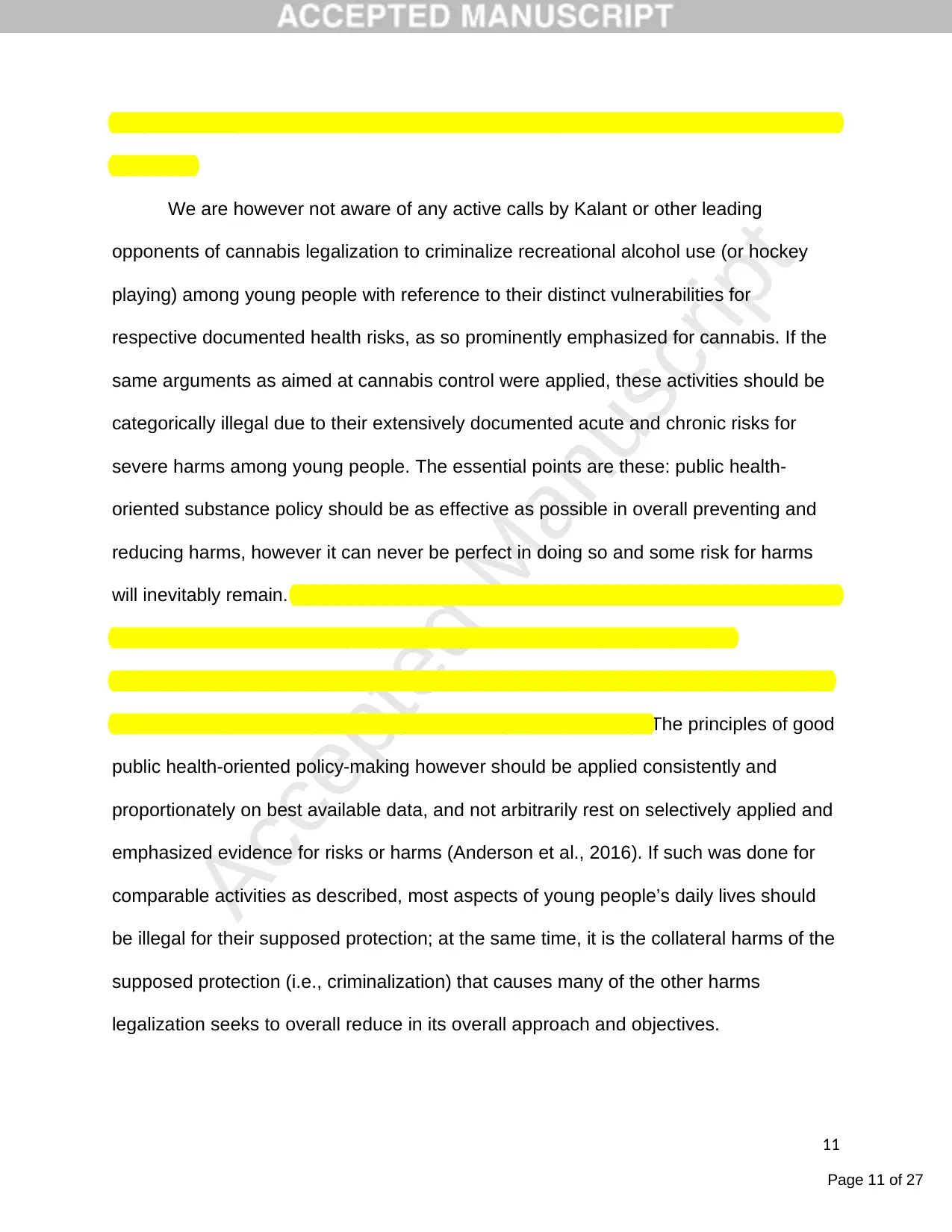
Page 11 of 27
Accepted Manuscript
11
people that is quite possibly higher than for cannabis (Cusimano et al., 2013; Forward et
al., 2014).
We are however not aware of any active calls by Kalant or other leading
opponents of cannabis legalization to criminalize recreational alcohol use (or hockey
playing) among young people with reference to their distinct vulnerabilities for
respective documented health risks, as so prominently emphasized for cannabis. If the
same arguments as aimed at cannabis control were applied, these activities should be
categorically illegal due to their extensively documented acute and chronic risks for
severe harms among young people. The essential points are these: public health-
oriented substance policy should be as effective as possible in overall preventing and
reducing harms, however it can never be perfect in doing so and some risk for harms
will inevitably remain. The evidence suggests clearly that the risks for health harms from
cannabis use among young people is, proportionally, not greater than other
(psychoactive substance and other) activities in which young people commonly engage
(or are broadly encouraged and expected to engage in) in today. The principles of good
public health-oriented policy-making however should be applied consistently and
proportionately on best available data, and not arbitrarily rest on selectively applied and
emphasized evidence for risks or harms (Anderson et al., 2016). If such was done for
comparable activities as described, most aspects of young people’s daily lives should
be illegal for their supposed protection; at the same time, it is the collateral harms of the
supposed protection (i.e., criminalization) that causes many of the other harms
legalization seeks to overall reduce in its overall approach and objectives.
Accepted Manuscript
11
people that is quite possibly higher than for cannabis (Cusimano et al., 2013; Forward et
al., 2014).
We are however not aware of any active calls by Kalant or other leading
opponents of cannabis legalization to criminalize recreational alcohol use (or hockey
playing) among young people with reference to their distinct vulnerabilities for
respective documented health risks, as so prominently emphasized for cannabis. If the
same arguments as aimed at cannabis control were applied, these activities should be
categorically illegal due to their extensively documented acute and chronic risks for
severe harms among young people. The essential points are these: public health-
oriented substance policy should be as effective as possible in overall preventing and
reducing harms, however it can never be perfect in doing so and some risk for harms
will inevitably remain. The evidence suggests clearly that the risks for health harms from
cannabis use among young people is, proportionally, not greater than other
(psychoactive substance and other) activities in which young people commonly engage
(or are broadly encouraged and expected to engage in) in today. The principles of good
public health-oriented policy-making however should be applied consistently and
proportionately on best available data, and not arbitrarily rest on selectively applied and
emphasized evidence for risks or harms (Anderson et al., 2016). If such was done for
comparable activities as described, most aspects of young people’s daily lives should
be illegal for their supposed protection; at the same time, it is the collateral harms of the
supposed protection (i.e., criminalization) that causes many of the other harms
legalization seeks to overall reduce in its overall approach and objectives.
⊘ This is a preview!⊘
Do you want full access?
Subscribe today to unlock all pages.

Trusted by 1+ million students worldwide
1 out of 28
Related Documents
Your All-in-One AI-Powered Toolkit for Academic Success.
+13062052269
info@desklib.com
Available 24*7 on WhatsApp / Email
![[object Object]](/_next/static/media/star-bottom.7253800d.svg)
Unlock your academic potential
Copyright © 2020–2025 A2Z Services. All Rights Reserved. Developed and managed by ZUCOL.



